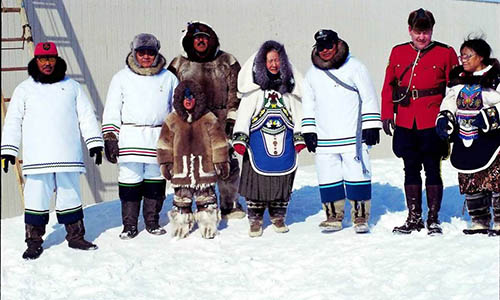On July 1, 1867, three colonies of British North America united to form the Dominion of Canada. This is known as the Canadian Confederacy and marks the birth of Canada. These three colonies were then divided into the four provinces of New Brunswick, Nova Scotia, Ontario and Quebec. Soon afterwards, in 1870 Hudson’s Bay Company agreed to sell Rupert’s Land and the North West Territories to Canada. In 1880 Britain surrendered the Arctic Islands (36,500 of them) to Canada. With further divisions and acquisitions Canada soon comprised 10 provinces and 2 territories. Provinces in Canada exercise constitutional powers. They have their own parliaments, make their own laws and have independent law enforcement agencies. The governance of the territories comes under the purview of the Parliament of Canada. The Federal Government maintains law and order through the Royal Canadian Mounted Police.
The most of the area of the territories lies above the latitude 600N. The territories occupy a huge land mass approx. 40% of Canadian land, but they are sparsely populated. Only 3% of Canada’s population live here. The harsh climate in the Northern territories ensured that the European colonists were not able to stamp out the local population. They did however treat them with disrespect and called them Eskimos, a derogatory term meaning ‘eaters of raw meat’. These native Canadians are also referred to as Aboriginals and are distinct from the Native American Indians. Part of the North West Territory comprised of about 22,000 Inuit as compared to a few thousand white Canadians. The Inuit successfully agitated for an independent territory within the Dominion of Canada. Nunavut Day celebrates the creation of the Nunavut Territory of Canada.
FACT 1: The Canadian Parliament passed the Nunavut Land Claims Agreement Act and the Nunavut Act on July 9, 1993. On April 1, 1999, Nunavut split from the North West Territory, to become the third Canadian Territory. Nunavut Day celebrates the creation of the Nunavut Territory.
FACT 2: Nunavut Day is a statutory holiday all over Nunavut, but is not a holiday in any other part of Canada.
FACT 3: Nunavut Day was first celebrated on April 1, 2000. April first was chosen as that was the day that the territory of Nunavut was carved out of the North West Territory. The date was then shifted to July 9, to commemorate the day that the historic acts, which led to the creation of Nunavut, were passed.
FACT 4: The Inuit comprise the majority of the population celebrate this day by honouring their traditional customs. Traditional games and dances are central to the celebrations. There are communal meals and the confluence of cultures ids celebrated in pancake breakfasts and barbeques.
FACT 5: As a territory of Canada, Nunavut is sustained by financial aid from the Federal Government. On Nunavut Day local leaders give speeches and announce policies and initiatives to stimulate financial stability.
FACT 6: Academic and Cultural Grants are also awarded on Nunavut Day. These Grants are given to Nunavut residents to pursue their studies or to develop traditional skills.
FACT 7: Different communities add their own distinctive flavour to the celebrations. Some communities build igloos, the traditional Inuit hunting shelters. These domed shelters used to be made of ice in winter.
FACT 8: In some communities burgers are served. These burgers are unique; the ‘beef’ comes from the musk ox, the traditional protein sustenance of the Inuit.
FACT 9: National Inuit Leader, Terry Audla, President of the Inuit Tapiirt Kanatami aptly described this day in his speech on July 9, 2012. “Today is a day for the Inuit of Nunavut to appreciate all that we have accomplished in the past several decades,” said Audla. “But it is also a day for all Inuit and all Canadians to celebrate our Arctic traditions and our way of life. Quviasugitsi Nunavut Ullunganit!”
FACT 10: About 3000 Inuit live in Ottawa, the capital of Canada. On Nunavut Day the Inuit of Ottawa celebrate by lighting the traditional Qulliq a stone lamp that is filled with seal oil. This is followed by drum dancing and throat singing. It also gives the Inuit of Ottawa an opportunity to communicate in their native language.











Leave a Reply